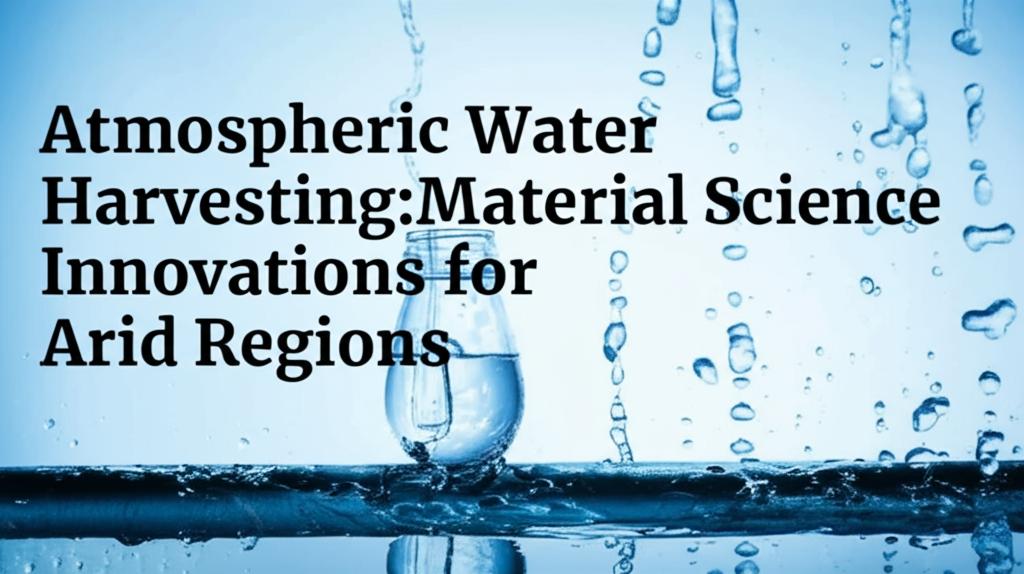The quest for fresh water in Earth's most parched regions is driving a wave of innovation in material science. Scientists are no longer just looking underground or to the seas, but to the very air we breathe, even in deserts. The challenge is immense: how to efficiently capture and condense water vapor when humidity is critically low. But recent breakthroughs are turning what once seemed like science fiction into tangible solutions, offering hope for a water-secure future.
At the forefront of this revolution are novel materials designed with incredible specificity to attract, hold, and release water molecules. Imagine a material that can autonomously pull moisture from arid air, even at humidity levels as low as 10% or 20%, and then release it as fresh, drinkable water. This isn't a dream; it's the reality of ongoing research that's yielding remarkable results.
Inspired by Nature, Perfected by ScienceNature has always been a profound teacher. Researchers are drawing inspiration from desert dwellers like beetles and lizards, which have evolved unique surface structures that combine water-attracting (hydrophilic) and water-repelling (hydrophobic) areas to capture airborne moisture. Mimicking these biological marvels, scientists are engineering "Janus" crystals and specialized hydrogel membranes. These smart materials possess a dual personality: one part eagerly grabs onto scarce water molecules, while another efficiently channels the collected liquid for harvesting.
One exciting development involves hydrogel "skins." These are not just simple sponges; they are sophisticated membranes, sometimes infused with hygroscopic salts like lithium chloride, which are powerful desiccants. These salt-loaded hydrogels can absorb many times their own weight in water, even in very dry air. The captured water can then be released using minimal energy, often just the warmth of the sun. Researchers at the University of Nevada, Las Vegas, have demonstrated a system using such a hydrogel membrane that can generate about a gallon of water per day from a square meter of material in Las Vegas, a city known for its aridity.
The Magic of MOFs and Nanoporous MaterialsMetal-Organic Frameworks (MOFs) are another class of superstars in atmospheric water harvesting. These are like microscopic sponges with incredibly large internal surface areas, making them exceptionally good at trapping water molecules. Scientists can tune the pore sizes and chemistry of MOFs to optimize them for water capture even at low humidity levels and for easy release with a gentle temperature increase, often achievable with solar energy. Some MOFs have shown the potential to produce several liters of water per kilogram of material per day, even in desert conditions.
Beyond MOFs, researchers have accidentally stumbled upon new classes of nanostructured materials. Scientists at the University of Pennsylvania, while working on an unrelated project, discovered an amphiphilic nanoporous material that combines water-loving and water-repelling components at a nanoscale. This unique structure allows the material to pull water from the air, collect it in its pores, and then spontaneously release it as droplets without needing any external energy input. This "capillary condensation" phenomenon within microscopic pores is a game-changer for passive water harvesting.
Passive Power: Radiative Cooling and Solar EnergyA key goal is to make these water harvesting systems as energy-efficient as possible, particularly for off-grid applications in remote arid regions. This is where passive strategies come into play. Radiative cooling is one such technique. Specially designed surfaces can dissipate heat to the cold sky, cooling themselves below the ambient temperature, which encourages condensation, much like dew forming at night.
Solar energy is another crucial element. Many advanced systems utilize solar heat to trigger the release of water from adsorbent materials. This solar-driven hygroscopic approach combines energy-efficient materials with the abundant sunlight typical of arid regions, creating a sustainable cycle of water capture and release. Some systems are even integrating photothermal components directly into the sorbent materials to enhance the efficiency of this process.
Overcoming Challenges, Unlocking PotentialWhile the progress is exciting, challenges remain. Scaling up production of these advanced materials, ensuring their long-term durability in harsh desert environments, and optimizing the overall system efficiency are active areas of research. The cost of these technologies is also a significant factor, though it's rapidly decreasing. Experts project that within five to ten years, atmospheric water harvesting could reach cost parity with municipal water, even in arid regions like Arizona.
The implications of these material science innovations are profound. They offer a decentralized, sustainable, and life-sustaining source of fresh water for communities grappling with extreme water scarcity. From providing drinking water in remote villages to supporting agriculture in desertified landscapes, atmospheric water harvesting is poised to become a vital tool in our global efforts to ensure water security for all. The air around us holds trillions of tons of water; thanks to these cutting-edge materials, we are getting closer than ever to tapping into this vast, renewable reservoir.

